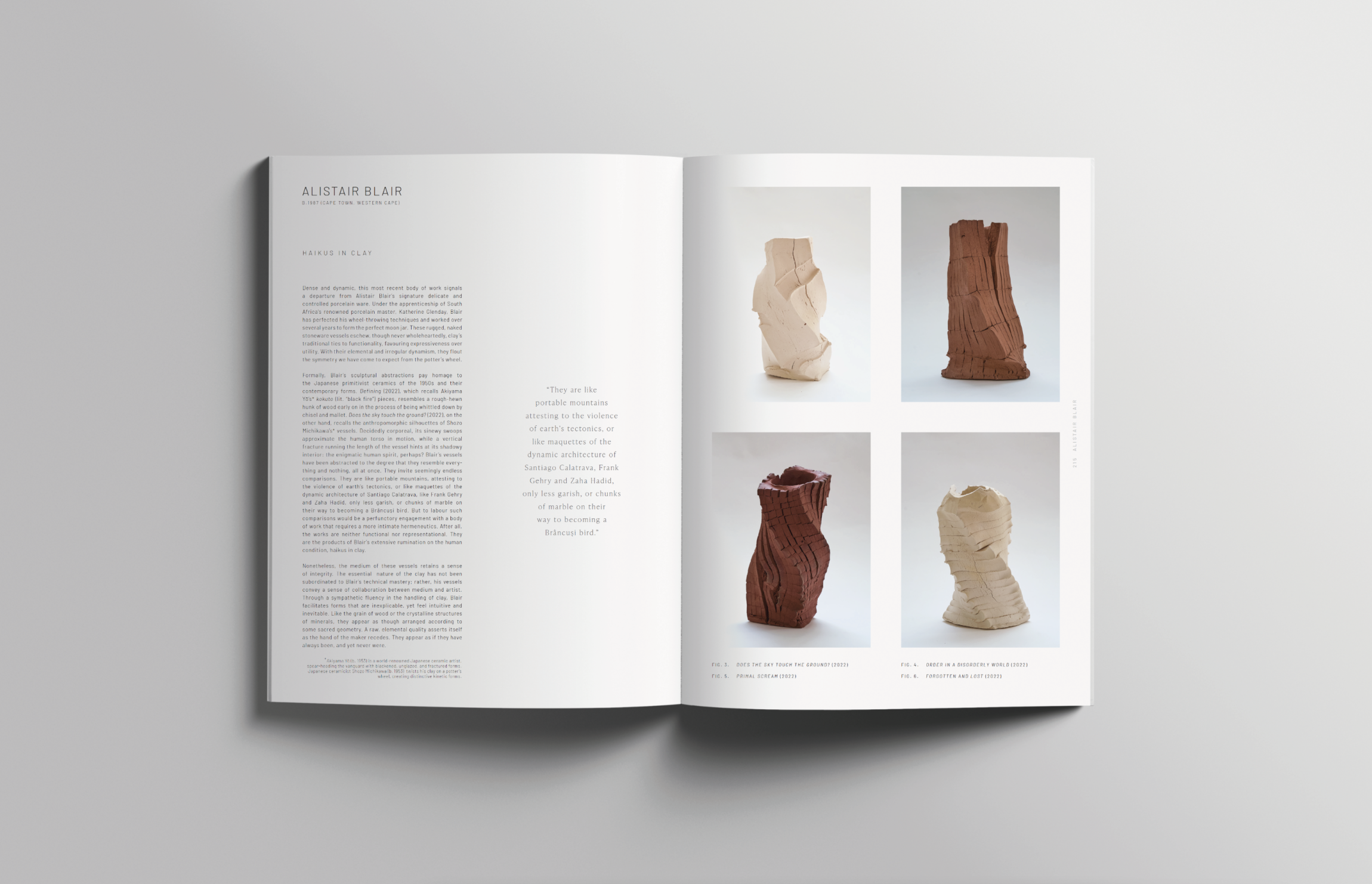
biography
alistair
blair
b. 1987
haikus in clay
fig. alistair blair, defining (2022)

Alistair Blair is an erstwhile oceanographer and ceramic artist living in Kalk Bay. After discovering Katherine Glenday’s studio in 2014, Blair’s clay practice was birthed and, since then, Glenday has been influential through a close and extended apprenticeship. The medium has served as a means of mapping the internal self – the fine forms like streams of milk, the scored and twisted clay skins, the edible chalky grey. Inspired by the non-ethos found in Taoist and wabi-sabi philosophies, Blair has formed his approach, asking the answerless, “How does one live a full life?” and allowing impermanent, roaming answers to satisfy it. With a background in cinematography, Blair’s clayworks inherit an immaculate patina and a striking visual theatricality (the drama of the contrasting stoneware and porcelain). Born by the sea, the ocean inhabits these works; a tongue to a piece might yield salt.
alistair blair
b. 1987 (cape town, western cape)
haikus in clay
Dense and dynamic, this most recent body of work signals a departure from Alistair Blair’s signature delicate and controlled porcelain ware. Under the apprenticeship of South Africa’s renowned porcelain master, Katherine Glenday, Blair has perfected his wheel-throwing techniques and worked over several years to form the perfect moon jar. These rugged, naked stoneware vessels eschew, though never wholeheartedly, clay’s traditional ties to functionality, favouring expressiveness over utility. With their elemental and irregular dynamism, they flout the symmetry we have come to expect from the potter’s wheel.
Formally, Blair’s sculptural abstractions pay homage to the Japanese primitivist ceramics of the 1950s and their contemporary forms. Defining (2022), which recalls Akiyama Yō’s kokuto (lit. “black fire”) pieces, resembles a rough-hewn hunk of wood early on in the process of being whittled down by chisel and mallet. Does the sky touch the ground? (2022), on the other hand, recalls the anthropomorphic silhouettes of Shozo Michikawa’s vessels. Decidedly corporeal, its sinewy swoops approximate the human torso in motion, while a vertical fracture running the length of the vessel hints at its shadowy interior: the enigmatic human spirit, perhaps? Blair’s vessels have been abstracted to the degree that they resemble everything and nothing, all at once. They invite seemingly endless comparisons. They are like portable mountains, attesting to the violence of earth’s tectonics, or like maquettes of the dynamic architecture of Santiago Calatrava, like Frank Gehry and Zaha Hadid, only less garish, or chunks of marble on their way to becoming a Brâncuși bird. The works are neither functional nor representational. They are the products of Blair’s extensive rumination on the human condition, haikus in clay.
The essential nature of the clay has not been subordinated to Blair’s technical mastery; rather, his vessels convey a sense of collaboration between medium and artist. Like the grain of wood or the crystalline structures of minerals, they appear as though arranged according to some sacred geometry. A raw, elemental quality asserts itself as the hand of the maker recedes. They appear as if they have always been, and yet never were.
“They are like portable mountains attesting to the violence of earth’s tectonics, or like maquettes of the dynamic architecture of Santiago Calatrava, Frank Gehry and Zaha Hadid, only less garish, or chunks of marble on their way to becoming a Brâncuși bird.”

fig. alistair blair, AN ESCAPE (2022)
read more with our publication
Clay Formes
contemporary clay from south africa
CLAY FORMES is the first of its kind: a survey of contemporary clay from South Africa. This volume, through exquisite photography and literary essays, showcases multiple generations of living South African artists, each innovating the potentialities of clay and ceramics. This publication offers enthusiasts and collectors a glimpse into the studios of thirty important South African artists and opens a window into the complexity of each body of work, revealing the richness of both contemporary clay and ceramic tradition within South African art.

This publication has sought to reflect its subject: to be as fluid as water and as weighty as earth. All this is done in the hopes of leaving behind a fresh approach to this manifold medium, and of presenting to the world the previously unexplored richness of sculptural clay in South Africa.
